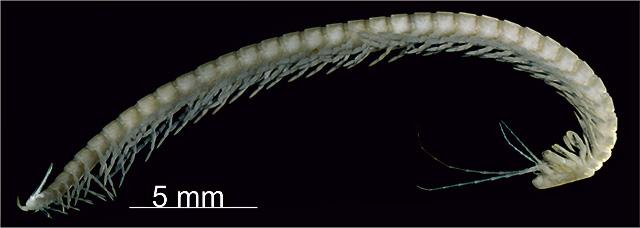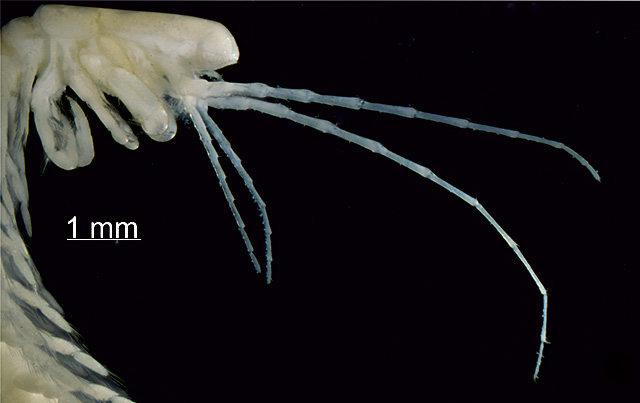Texas A&M Galveston scientists part of international team discovering amazing new sea life from submerged cave in Cozumel
Tweet An international team consisting of scientists from Texas A&M University at Galveston, Denmark, Norway and Mexico have discovered a new species of remipede, a rare group of crustaceans exclusively inhabiting saltwater caves. Crustaceans are a large and diverse group, including familiar animals such as crabs, shrimp, lobsters and barnacles.
An international team consisting of scientists from Texas A&M University at Galveston, Denmark, Norway and Mexico have discovered a new species of remipede, a rare group of crustaceans exclusively inhabiting saltwater caves. Crustaceans are a large and diverse group, including familiar animals such as crabs, shrimp, lobsters and barnacles.
While exploring a 6-mile long underwater cave on the Mexican island of Cozumel, Texas A&M Galveston marine biologists Dr. Tom Iliffe and Dr. Pete van Hengstum noticed shallow pools of saltwater on floor of the submerged cave passage. Although this long cave primarily functions as an underground river, carrying freshwater to the Caribbean Sea, in a few places it is deep enough to intersect underlying saltwater. In these saltwater pools, the scientists collected several small, inch long animals that have been identified as a new remipede species.
Remipedes are slender, multi-segmented crustaceans, lacking eyes and body pigmentation. They continuously swim in an inverted position and superficially resemble a swimming centipede. With their unique venom injecting fangs they have been observed to seize small shrimp as their prey.
“Quite unexpectedly, recent molecular genetic studies have found a close relationship between remipedes and insects suggesting that further studies of remipedes are critical to understanding the early evolution of insects and the movement of life out of the sea to land’, said Iliffe. “With 28 species of remipedes identified in the past 36 years, discovery of a new species is a relatively rare event.”
Most remipedes are found in the Caribbean region. The Bahama Islands appear to be the center of diversity with 20 species, but two species inhabit Canary Island caves on the opposite side of the Atlantic and one species occurs in a cave on the Indian Ocean coastline of Australia.
“This new species is the first remipede recorded from Cozumel,” said van Hengstum. “Two related species inhabit caves along the adjacent mainland coast of the Yucatan Peninsula, while another comes from a seafloor cave off Belize.”
Together, these four species belong to the genus Xibalbanus, derived from the name for the underworld in ancient Mayan mythology. The new species was named cozumelensis, referring to the island where it was discovered.

The body of Xibalbanus cozumelensis consists of up to 39 segments with each, except the last, having paddle-like limbs for swimming. Sexes in remipedes are combined such that each individual simultaneously has male and female reproductive organs. Mating has never been observed and little is known of their life history, with the exception of multiple larval stages observed for only one species.

Another unusual observation was the presence of suctorian ciliates. These tiny, single-celled protozoans live on a stalk, attached to the outer surface of limbs and antennae of the new species. The suctorians likely benefiting from their attachment to a swimming host, but don’t harm it.
Geological evidence indicates that the Yucatan Peninsula has been separated from Cozumel by a deep-water channel for perhaps as long as 65 million years. Such long-term geographic isolation might explain the existence of remipede species in both areas.
“Genetic similarities between Cozumel and mainland Yucatan remipedes hint that a more recent migration might have occurred, possibly through deep-water cave systems extending beneath the Cozumel channel,” says Iliffe. “Underwater caves, along with the deep sea, are vast, unexplored frontiers for exploration and discovery. Who knows what other strange lifeforms await discovery.”
Description of the new species was published in the European Journal of Taxonomy and can be accessed at https://doi.org/10.5852/ejt.2017.316. Additional information on Iliffe’s cave studies can be found on his website http://www.cavebiology.com.
###
More:
Science & Technology